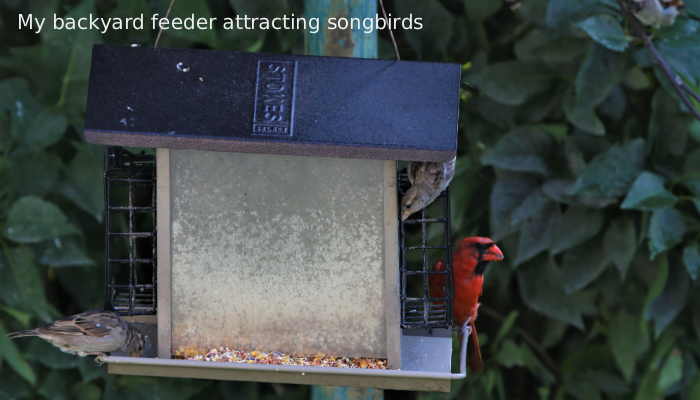White-winged Crossbills at the Feeder: Diversity Attracting Diversity

In August I get a bit of that countdown feeling I always got in grade school knowing my days of freedom were numbered as the school year loomed. Now the countdown means the hours of daylight shorten and there is less time to work outside. It also means the impending departure of the Orchard and Baltimore orioles that return to our feeder each summer. In another couple of weeks, they’ll move on to points south and not until next May will we hear their lilting songs from high tree tops or their chattered conversations in the backyard.
And yet there are still many things to be enjoyed as summer winds down – like the Perseid meteor showers, and this year, the August 21 eclipse – as well as the more down-to-earth pleasures of greens from a fall garden, goldfinches, still bright yellow, that cling to the seed sock in the lilac bush outside our kitchen window, and just being open to the unexpected.
A few days ago, while doing the dishes, I noticed a patch of pale red through the lilac leaves. Something odd was on the seed sock.
I dried my hands, fumbled with my binoculars, and crept to the side door for a better look. It was a pale red bird with white bars on black wings. The yellowish-gray female sat near it on another branch. I retrieved the bird guide and discovered they were White-winged Crossbills. Roger Tory Peterson’s guide describes the male as a pale rose color while the Audubon Society Field Guide calls him raspberry-pink. The crossed bill is hard to see, and I didn’t make it out on this pair, nor could I see the white bars that also distinguish the female, but she had dark streaks all over, which suggests she was immature.
Various guides describe them as “irregular vagrants” or “nomadic.” Kenn Kaufman, field editor for Audubon, wrote about White-winged Crossbills in a January blog post of this year calling them “the bird that never goes home.” They feed on seeds they extract from the cones of spruces and tamaracks, something for which their crossed bills are uniquely suited. Because the abundance of the cones is inconsistent and unpredictable, they will fly long distances to find a good source. Range maps show their home territory spanning from Canada into Alaska, but a line beginning in the northeast United States drops down through the country’s midsection before looping back up to British Columbia, denoting how far afield these birds can travel.
They are also described as very tame. Indeed, they took their time enjoying my nyger seed, then flew to the higher branches of a nearby tree where they perched for some time.
Sightings at backyard feeders are rare but not unheard of. A feeder was nearby at my house, but apparently, these charming birds will try a seed sock as well.
Why would the White-winged Crossbills come to our yard, I wondered? We have a feeder with a regular mix of bird food, the seed sock sheltered in the lilac bush, and an oriole feeder supplied with grape jelly all summer. Although nothing unique, these attract quite an array of birds. As for plantings around our house, I go for the “natural” look because nature doesn’t care for uniformity. Monarda, hyssop, milkweed, and mallow crowd over the sidewalk. We also have coneflower and black-eyed susans. These have attracted more pollinators than we’ve seen in years. I like to think that diversity attracts diversity. But perhaps the crossbills simply discovered the conifers in our neighborhood or the stand of cone-bearing trees in our town’s small cemetery a mile or so away and stopped by on a whim. Whatever the reason, I’m glad they came.
Tags: bird habitat, conservation, Diane DeBok, White-winged crossbill

